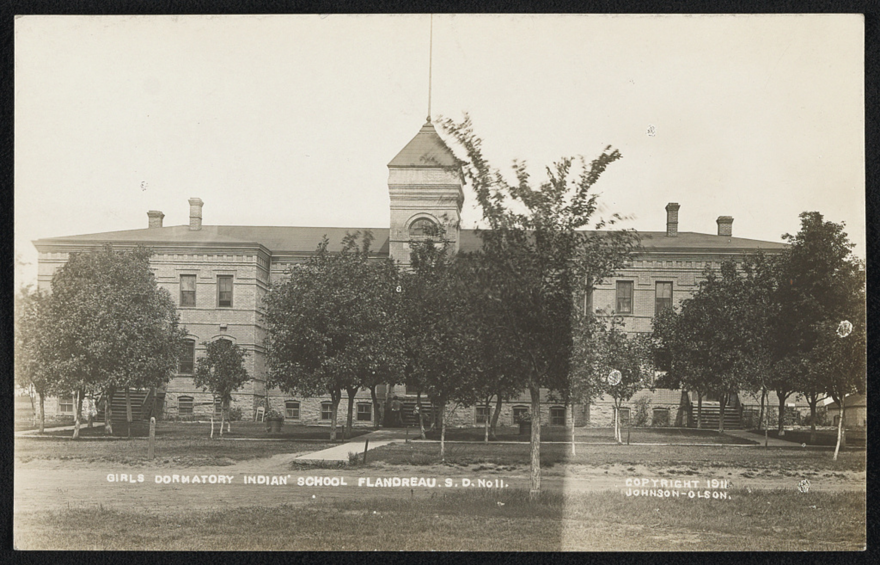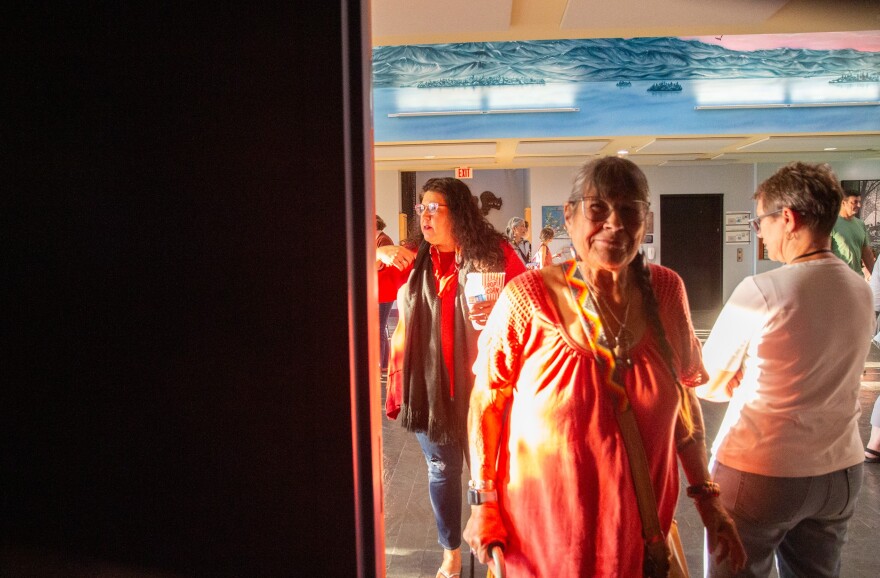Editor's note: A warning that this story covers sensitive material, including sexual abuse.
Earlier this month, a documentary called Sugarcane showed at the Main Street Landing Film House in Burlington.
It takes up something that’s pretty hard to talk about: residential schools.
These schools, also called boarding schools, were government-sponsored, church-run institutions that Indigenous children attended — often by force — during the 19th and 20th centuries in the U.S. and Canada.
The schools were designed to strip children of their Indigenous language, culture and community, and assimilate them into white, Christian, European society.
Investigations by both federal governments have since shown that thousands of children died at these institutions. They also note widespread physical and sexual abuse that created lasting trauma for survivors and their descendants.

"You can't sit in a room and then just start talking about it," says Beverly Little Thunder, a 76-year-old Huntington resident and Lakota elder, enrolled in the Standing Rock Sioux Tribe in North Dakota. Several generations of her family have firsthand experience with these boarding schools.
"It has to be something that people are are willing to talk about," Beverly says. "And a lot of our elders, you know, who are in their 80s and 90s, they just kind of shake their heads and get this, you know, sad look on their face and: 'Yeah, that was hard.' And then change the subject."
But she adds that this documentary, Sugarcane, is helping bring up the conversation.
"There's been a lot of, you know, a lot of chatter online, in the Native community," she says.
Beverly and her daughter, Lushanya Echeverria, attended the Burlington screening of Sugarcane with Vermont Public reporter Elodie Reed.
This story was produced for the ear. We highly recommend listening to the audio. We’ve also provided a transcript, which has been edited for length and clarity.
Elodie Reed: In the car on the way to the theater, Beverly shares what she knows about her mom’s and aunt’s time in boarding school.
Beverly Little Thunder: One time she and my mom were talking, and I was sort of eavesdropping. I was doing something in the room. And my aunt Gloria said, "Christina," she says, "Remember the time that they put us each in a closet and locked the door and left us there overnight?" And she's — "Because we were playing with our dolls and we were talking in Lakota?" And my mom said, "Yeah." My aunt said, "We were just 4 years old." She says, "What makes someone do that to a baby?" She said, "We were still babies." And she started crying, and my mom started crying.
I really don't know, you know, the extent of what her — how it affected her. I know that she — you know, she was not real physically affectionate. But then, how could she be? I'm sure she was modeling after people that she was around when she was growing up.
Elodie Reed: Which school did your mom go to?
Beverly Little Thunder: She went to Flandreau.
Elodie Reed: Flandreau Indian School, in South Dakota, is on the United States’ list of Federal Indian Boarding Schools. It still operates as a federally run, off-reservation boarding school for Indigenous students, one of the few left in the country.

Elodie Reed: And Beverly, did you attend a boarding school?
Beverly Little Thunder: I was in boarding school for about six months, and then I was sent to another boarding school for about six months. Then I went to another boarding school. And I was sent up to a school called Intermountain, up in Utah.
Elodie Reed: Intermountain Indian School is also on the list of Federal Indian Boarding Schools. It operated from 1950 to 1984.
Beverly Little Thunder: They were mean. That's all I can say is, they were mean. You know, I don't think anyone ever spoke with a kind word or a gentle way. They would pull our hair. It was past the time when they would cut your hair, and past the time when, you know, you would get in trouble if you spoke your language. But by then, most of the kids that were there didn't speak their language.
There was also a lot of Christian doctrine that, you know, was spilled on us. And I was like, "I don't like this," so — and I was old enough where I felt like I could make it on my own — so I ran away.
Elodie Reed: How old were you?
Beverly Little Thunder: I was probably about 13.
Elodie Reed: 13?
Beverly Little Thunder: Yeah.
Elodie Reed: As we drive toward the theater, I ask Beverly how she’s feeling about going to see a documentary that, inevitably, will reflect some of these experiences.
Beverly Little Thunder: It was something that I wanted to see. I know that it'll probably evoke some emotions, but I think that film and its content should evoke emotions, and it can be a reminder of the work that still needs to be done.
Elodie Reed: We arrive in Burlington just as the sun casts a deep, golden hue over Lake Champlain. Beverly’s daughter, Lushanya, turns around from the front seat to look at her mom, who's in the back with me.
Lushanya Echeverria: All right, Mom.
Beverly Little Thunder: What?
Lushanya Echeverria: We're gonna let you off here.
Beverly Little Thunder: OK.
Lushanya Echeverria: And we're just gonna go park.
Beverly Little Thunder: OK.
Elodie Reed: We all walk into the Main Street Landing building.
Elodie Reed: While we’re walking, Lushanya, can you tell me why you're here as well?
Lushanya Echeverria: This story is very interesting to me because the matriarchs in my family are from — were raised with the boarding school mentality, mindset and practices. But also, as an educator, I worked with many Native American families, whose families — their participation in boarding schools impacted their current, modern day students’ attendance at school and trust in schools. So I worked with a lot of families around boarding school trauma, trauma healing, and stuff.
Elodie Reed: Inside, Beverly and Lushanya get some popcorn.
Lushanya Echeverria: Do you wanna taste it? Make sure it's—
Beverly Little Thunder: —not like salt.

Elodie Reed: Then we all find our seats in a sold-out theater.
Beverly Little Thunder: I'm just looking around, trying to see if there's other Native people here, and I don't see any yet.
Lushanya Echeverria: We've overheard some people saying that because of the title, they thought it was about sugarcane, and they're very surprised about what the topic is. That's always great. (Laughter)
Elodie Reed: Just before the lights go down, Lushanya leans toward Beverly to make sure she has some tissues. And then:
Steve MacQueen: OK everybody, we’re gonna start in just a couple of minutes.
Elodie Reed: I’m gonna turn this off.
Sugarcane trailer: I have felt dirty as Indian all my life in residential school.
Elodie Reed: The nearly two-hour film braids together three stories stemming from the British Columbia-based Williams Lake First Nation. The reserve is known as Sugar Cane, and the residential school there was St. Joseph’s Mission.
It follows an investigation into the atrocities that took place at the Catholic-run school.
Sugarcane trailer: For decades there were reports of neglect and children dying or disappearing from this facility.
Elodie Reed: It bears witness to survivors voicing their stories, including filmmaker Julian Brave Noisecat’s father.
Sugarcane trailer speaker 1: You do know what happened with me, right?
Sugarcane trailer speaker 2: I wanna know the whole story.
Elodie Reed: And it documents another survivor as he seeks accountability from the Catholic Church.
Sugarcane trailer: Being sorry for something is just the first step, you have to take action.
Elodie Reed: The film holds these stories and surrounds them with scenes of natural beauty, affection between family, vibrant culture and solemn spirituality. Behind it all is a resonant score composed by Odanak First Nation musician Mali Obomsawin.
At the end of the documentary, statistics flash across the screen to remind the viewer that, while this is the story of one community, these schools — designed for Indigenous cultural erasure — were built across Canada, across the United States.
In fact, one school on the list was in Vermont. While different in scale to the residential schools that operated for decades assimilating thousands of Indigenous youth, a Baptist missionary did send two Potawatomi teenage boys to the medical school in Castleton in the late 1820s.
That’s according to reporting by the Burlington Free Press. The Free Press also found out that those two boys died from tuberculosis within a few years, and that “both were stripped of their Native identities by the times of their deaths.”
As the theater lights come back up and audience members begin to chatter, Beverly and Lushanya stay silent, except for blowing their noses.
We continue in silence, out of the theater and into the building lobby. There, Beverly takes a seat, and she begins to speak.
Beverly Little Thunder: That was hard.
I think about all the people I know my age, that suffered through their parents, their parents' dysfunction, and probably some of them didn't even understand why.
They kept talking about healing, they kept using that word "heal." But I wondered — I thought I knew what it meant, but I don’t think I know what it means. Because how do you heal from something like that?
Elodie Reed: Beverly notes the moment in the film when a residential school survivor goes to the Vatican, to ask for some kind of response to the well-documented sexual abuse of Indigenous children, perpetuated by the Catholic Church.
During the summer of 2022, Pope Francis traveled to Canada to give a formal apology for the church’s role in the residential school system.
And for Beverly, this brings up a personal experience she had as a child in a church-run orphanage — where she lived in addition to federally run boarding schools.
Beverly Little Thunder: I was sexually abused by a nun. I know what it's like not to talk about it.
And wasn't it nice, that the Pope said he was sorry. It’s so easy to say, "I'm sorry," after the damage is done.
I have so much going through my mind right now.

Elodie Reed: One of those things running through Beverly’s mind, is the response of the people in the theater around her to what they just witnessed.
Beverly Little Thunder: Even listening to them clap, seeing it as, you know, an art form, a film. How done, well-done it was, and how it was produced.
And I just wondered how many people that were sitting around me that saw it really understood. (Crying)
I heard two ladies talking about their geraniums.
Elodie Reed: I noticed you both holding hands a number of times. Beverly, how did it feel to have Lushanya next to you?
Beverly Little Thunder: I was glad she was there.
Lushanya Echeverria: You want me to kick their asses, the geranium [bleeped]?
(Laughter)
Beverly Little Thunder: No, go find out what variety they were. (Laughter)
Sensitivity editing for this story was provided by Myra Flynn.
Have questions, comments or tips? Send us a message.
_





